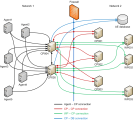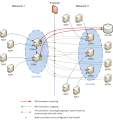Net Areas in the Automation Engine
Communication processes (CP) are used to connect components such as agents and the Automic Web Interface with the work processes (WPs) and to handle the communication. The communication process (CP) selection for the individual components takes place automatically and is workload-dependent. When an Automation Engine system uses several communication processes (CPs), you can distribute them over several areas to manipulate their selection. Ideally, each area represents a specific network. For more information, see Communication Processes (CP).
This page includes the following:
Default CP Selection
- The agent attempts to connect to a randomly selected communication process (CP) as specified in the parameter CP.PORTS= in the [PORTS] section of the INI file of the Automation Engine, see Automation Engine.
- The agent selects the communication process (CP) with the best connection count. One communication process (CP) can handle 99999 connections on all platforms. The exceptions is zLinux where the limit is 65000.
- Upon establishing a connection, the communication process (CP) provides the client (Automic Web Interface or agent) the performance values for the connection and information about all addresses of communication processes (CP) known in the system.
- The addresses are used to update the corresponding sections of the INI file entries.
Note: It is recommended to run communication processes (CPs) and work processes (WPs) in the same secure network zone. Should the communication processes (CPs) be located in different network zones, separated by a firewall, please observe and configure the necessary firewall exceptions. Upon connecting to the Automation Engine, the agents get a complete list of communication processes (CPs) to enable their selection. In case the communication processes (CPs) are behind a firewall (from the agent's point of view), the connections of the agents to the communication processes (CPs) have to be configured in the firewall itself.
Extended CP Selection (Net Areas)
The communication process (CP) selection can be restricted to certain communication processes (CPs) by grouping them into network areas. To do so, use the NetArea= parameter in the [TCP/IP] section of the INI file of the Automation Engine (see Automation Engine). The values for net area parameters have to be alphanumerical and have to start with a letter. If the parameter is not defined, the name of the Automation Engine system is used instead.
Note: Only communication processes (CPs) can be grouped in net areas. The work processes (WPs) of an Automation Engine system must use the same net area. Any attempt to start a work process (WP) in a different net area than the one of the active work processes (WPs) results in the work process (WP) ending itself immediately.
You may use any number of net areas. To ensure stability, it is recommended to use at least two communication processes (CPs) in each net area.
The extended communication process (CP) selection follows a specific sequence:
-
An agent starts and contacts the communication process (CP) as specified in the cp= parameter in the [TCP/IP] section of the agent's INI file. Should the agent not be able to connect to this communication process (CP), it will try to connect to one of the communication processes (CPs) listed in the CP_LIST section of the agent's INI file.
-
The communication process (CP) sends a list of all communication processes (CPs) that are located in its net area to the agent.
-
The agent contacts all listed communication processes (CPs).
-
The agent selects the communication process (CP) with the smallest number of connections and connects to it.
Examples
You can use net areas for different purposes:
-
Use separate communication processes (CPs) for the Automic Web Interface and agents
Define two net areas, assign them communication processes (CPs) and enter a communication process (CP) in the INI file of the client (Automic Web Interface or agent) respectively, depending on the communication process (CP) of the desired net area to be contacted on first start.
-
Use communication processes (CPs) in separate network zones
Select a net area for each network zone. Use the net area to assign the communication processes (CPs) to the network zones they are located in. If an Automic Web Interface, CallAPI or agent connect to a communication process (CP) within its own network zone, the AWI, CallAPI or agent will choose only from the available communication processes (CPs) in this net.
Important! Remember to delete the CP_LIST paramter in the INI file of the agent , in case you change the assignment of the communication processes (CPs) to the different net areas.
Configuration examples
The following scenario represents a situation where it is useful to limit the communication processes (CPs) for their selection by the agent.
An Automation Engine system is divided into two different networks. Both networks use agents. Network 1 contains server processes, communications processes CP001, CP002 and CP003, and the database. In Network 2, the communication processes CP004 and CP005 are being used. These communication processes serve to connect the agents of Network 2 with the server processes (CPs and WPs) in Network 1. The two network areas are separated by a firewall that is configured statically and should only accept known connections.
The following diagram shows the net area InnerNet and its assignment to the communication processes (CPs) CP001, CP002 and CP003 whereas net area OuterNet is assigned to CP004 and CP005.
The following diagram shows the connections between components and their directions, indicated by arrows. The agents of Network 1 connect exclusively to communication processes (CPs) of the InnerNet net area, the agents of Network 2 connect exclusively to communication processes (CPs) of the OuterNet net area. In this case, the agents' connections do not have to be configured in the firewall. The diagram also shows the necessary connections for communication process (CP) operation in other network zones. For Network 1, only database connections by communication processes (CPs) drawn in red are known. Please note that connections between communication processes (CP-CP) only occur in special cases or are necessary if an agent's registered output file should be displayed by way of the Automic Web Interface, where agent and Automic Web Interface are connected to different communication processes (CPs). These connections are denoted by red dotted lines.
Note: In the firewall, you only have to configure connections that are known to CP004, CP005, regardless of the number of agents that are used in Network 2. Connections that must be configured statically are shown as red dots along the firewall line.
To ensure that the agents only connect to CP004 and CP005 the following steps are required:
-
For CP001, CP002 and CP003:
-
the communication processes (CPs) CP001, CP002 and CP003 have to be combined in one net area
Set the NetArea= parameter in the [TCP/IP] section of the INI file of the Automation Engine (see Automation Engine). You can specify any name for the network area as the value (InnerNet).
-
In the cp= parameter in the [TCP/IP] section of the INI file of the agents of Network 1, you can use the connection data of either CP004 or CP005 CP001, CP002 or CP003
-
-
For CP004 and CP005:
-
the communication processes (CPs) CP004 and CP005 have to be combined in one net area
Set the NetArea= parameter in the [TCP/IP] section of the INI file of the Automation Engine (see Automation Engine) of these communication processes (CPs). Make sure that you use a different value from the one defined for the communication processes (CPs) in Network 1 (OuterNet).
-
In the cp= parameter in the [TCP/IP] section of the INI file of the agents of Network 2, you can use the connection data of either CP004 or CP005
-
The following INI file parameters must be specified in the Automation Engine:
Network 1
[GLOBAL]
system=UC4
[TCP/IP]
pwpPort=2270
NetArea=InnerNet
[PORTS]
CP.PORTS=2217-2219
Network 2
[GLOBAL]
system=UC4
[TCP/IP]
pwpPort=2270
NetArea=OuterNet
[PORTS]
CP.PORTS=2220-2221
ServiceManager
When you start server processes or agents from the Administration perspective in the Automic Web Interface or by using the script element MODIFY_SYSTEM, the work process (WP) selects a communication process (CP), and the communication process (CP) contacts the responsible ServiceManager (see ServiceManager). If the communication processes (CPs) are located in different net areas within the Automation Engine system, it is considered for the communication process (CP) selection.
The following behavior applies:
-
Start an agent, communication process (CP) or work process (WP) by using the script element MODIFY_SYSTEM or via the Administration perspective.
Note: On startup via the Administration perspective, the communication process (CP) to which the Automic Web Interface is connected passes the request on to a work process (WP).
-
The work process (WP) responsible contacts the communication process (CP) that is located in the same net area as the agent, communication process (CP) or work process (WP) that should be started.
-
If the work process (WP) does not find a communication process (CP), it will search for a communication process (CP) in its net area.
-
If it still cannot find a communication process (CP), the work process (WP) contacts any communication process (CP) of the Automation Engine system.
-
The selected communication process (CP) contacts the related ServiceManager which starts the agent, communication process (CP) or work process (WP).
See also:
- Multi-Server Operations
- Server Processes
- Types of Server Processes
- Administration Perspective
- Configuring Automic Automation
- Configuration (INI) files of Agents

